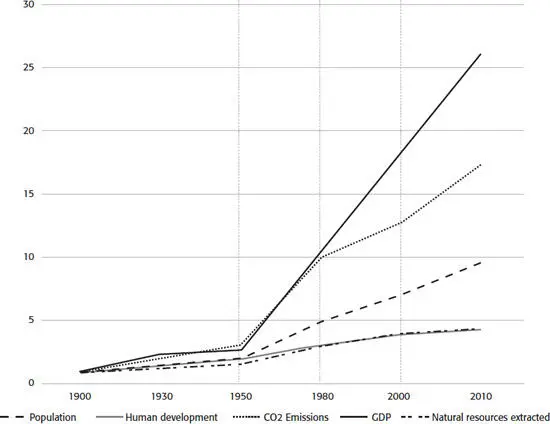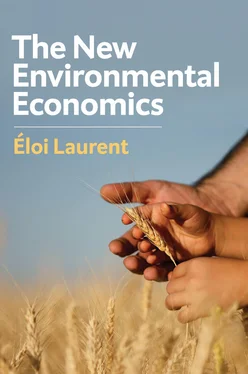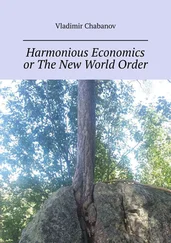But, if Malthus was wrong on substance, he was not mistaken about the form: A great desynchronization, potentially more destructive than the one he had imagined, did indeed start on his watch. Consider, to measure it as precisely as possible, five fundamental indicators of human development for about a century: population, human development (income, health, education), gross domestic product (GDP), carbon dioxide emissions, and extraction of natural resources (Graph 1.1).

Graph 1.1Three ages of human development* (factor of increase: 1900 = 1)
* The historical human development index aggregates, on an equal weighted basis, an income indicator, an education indicator and a health indicator.
Source: Human Development Report database, Global Carbon Project. Leandro Prados de la Escosura, World Human Development, 1870–2007, Review of Income and Wealth , 61 (2), June 2015: 220–247 and Maddison Project Database and Krausmann Fridolin, Simone Gingrich, Nina Eisenmenger, Karl-Heinz Erb, Helmut Haberl, and Marina Fischer-Kowalski, 2009. “Growth in global materials use, GDP and population during the twentieth century.” Ecological Economics , 68 (10), 2696–2705
What can we discern? There are clearly three periods, three ages of human development whose characteristics differ quite sharply: In the first age, the first half of the twentieth century, population increases and human development grows even faster. Malthusian pessimism is spectacularly invalidated: “More people on average experience greater well-being. CO 2emissions are growing a little faster than human development, but at a slow pace, extraction of natural resources grows at the pace of human development and Gross Domestic Product (GDP) reflects, exaggerating a little, a new prosperity of the human species, seemingly compatible with the preservation of its habitat, the biosphere.”
During the second period, between 1950 and 1980, the great desynchronization begins: While the growth of human development slows down and is gradually caught up by that of the population, CO 2emissions and GDP are racing and natural resources extraction is multiplied by 2.5. At the end of the period, in 1980, CO 2emissions and GDP grew by a factor of ten compared with the beginning of the twentieth century, tripling the pace of population growth and human development.
The third age of human development is the time of illusion: While population and human development are stabilizing at the same rate of growth, CO 2emissions continue to grow much faster than both, and natural resources extraction doubles again, while GDP, completely disconnected from human reality, masks the gravity of the ecological crisis (in that period, biodiversity declines substantially).
The increase in human development in the second half of the twentieth century has been achieved at the cost of environmental degradation (in the form of CO 2emissions) four times higher than in the first half of the century, even though the population increased only slightly more than in the years between 1900 and 1950 (2.4 against 1.6). It is therefore mostly the qualitative means of human development that are in question – and not just the quantitative demographic pressure – in the explosion of post-Second World War environmental degradation. The beginning of the twenty-first century is even more “inefficient” when we relate human well-being to its ecological cost. Emissions growth increases at its highest rate ever (almost 75%), contrasting with the growth of human well-being and population (only 10%) and up to 1 million species are threatened with annihilation because of human activity.
To sum up: Between 1900 and 1950, it was necessary to triple CO 2emissions to obtain a doubling of human development. Between 1950 and 2000, this same doubling required more than a quadrupling of CO 2emissions. At the beginning of the twenty-first century, a doubling of human well-being would be achieved at the cost of a multiplication by almost eight of the CO 2emissions responsible for climate change. In other words, Malthus has his accounting revenge and we are faced with a new crisis of paces: To the now synchronized arithmetic growth of the population and well-being responds the geometric progression of environmental degradation that will eventually overcome human recent and fragile prosperity.
How do we get out of this trap? Faithful to the idea that there is no problem whose absence of solution cannot be exhausted, we can think first of all that this great desynchronization will be solved by itself, in the fashion of Malthus, by amputation of human well-being and disappearance of the least resilient part of the population. The health consequences of climate change are, in fact, becoming better known and more and more tangible (see Chapter 9). Climate change and the ecological crises it will aggravate have, no doubt, the power to destroy in a few decades the human progress of the last two centuries. The Malthusian stagnation was explained precisely by famine crises, which “naturally” regulated the level of the population. Malthus himself was in favor of abandoning the poorest part of the population to its fate by suppressing the laws that could support it.
This Malthusian method is the implicit choice made by human societies at the beginning of the twenty-first century: About 90% of the so-called natural catastrophes of the last twenty years are linked to climatic phenomena, and they have affected the existence of 2.3 billion people, who live for the most part in the poorest countries on the planet. The current rate of degradation of the biosphere promises the world’s most vulnerable hell on Earth.
Malthus leaves us with a haunting intuition of our sustainability crisis and a dismal response to it. David Ricardo, over whom Malthus exerted a strong intellectual influence, offered more humane responses in dealing with the inescapable limits of human development on a finite planet.
David Ricardo and planetary boundaries
“Planetary boundaries” are quantitative thresholds “within which humanity can continue to develop and thrive for generations to come.” Crossing these boundaries entails the risk of generating large-scale abrupt or irreversible environmental changes. Scientists warned us recently that “Four of nine planetary boundaries have now been crossed as a result of human activity: Climate change, loss of biosphere integrity, land-system change, altered biogeochemical cycles (phosphorus and nitrogen).” Two of these, climate change and biosphere integrity, are “core boundaries.” Significantly altering either of these would “drive the Earth System into a new state.” 7This is certainly breakthrough science, yet the classical economists from the eighteenth and nineteenth centuries had the intuition that human development was in fact constrained by the scarcity of Nature.
What has been referred to as the “grandiose dynamic” of the English classical school (whose major triad includes Adam Smith, David Ricardo, and John Stuart Mill) is based on the assumption of the domination of Man by Nature. In the view of the authors, Man does not (cannot) destroy Nature: He takes advantage of his fertility but, in return, Nature imposes on him his rhythm of exploitation and his finitude, and promises him a stationary state as an horizon. According to the classics, economic growth is only possible as long as all available land is not exploited, agricultural productivity being a gift that cannot be manipulated by technological progress.
It is not the prospect of the deterioration of natural resources, let alone the depletion of natural stocks, that leads to the melancholic conclusion of the classics, but the comparison between what the Earth can offer and what it takes for humans to subsist. The analysis of Malthus was the most accomplished expression of this disillusioned comparison before David Ricardo developed his idea of “diminishing returns” and John Stuart Mill his vision of the “stationary state.”
Читать дальше













